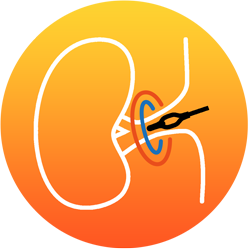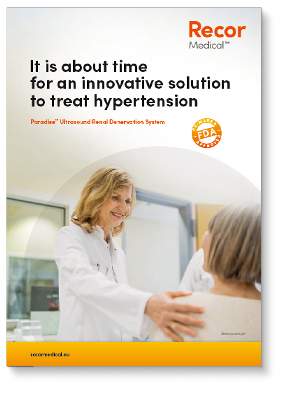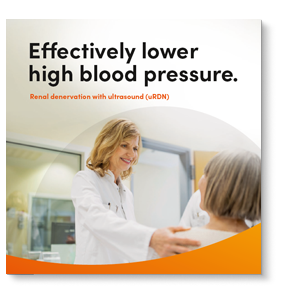Hypertension Specialist
Effective blood pressure reductions.
Effective blood pressure reduc-
tions.
Renal denervation (uRDN) with ultrasound


Renal denervation (uRDN) with ultrasound
Recommended treatment pathway
Recommended treatment pathway
The European Society of Cardiology (ESC)¹ and the European Society of Hypertension (ESH)² recommend renal denervation as a treatment option for hypertension.
The European Society of Cardiology (ESC)¹ and the European Society of Hypertension (ESH)² recommend renal denervation as a treatment option for hypertension.
- The first objective of antihypertensive treatment for all patients is
to reduce blood pressure to < 140/90 mmHg.1,2 - If the drug treatment is well tolerated, blood pressure values of 120-129 / 70-79 mmHg
or lower should be aimed for.1,2

Lifestyle Changes

Medications

Renal denervation with ultrasound
1 Barbato et al. Eur Heart J. Apr 17, 2023;44(15):1313-1330
2 Mancia et al. Journal of Hypertension 2023, 41:1874-2017
The three pillars for the successful treatment of high blood pressure¹

Changes in lifestyle habits
- Reduce salt intake, stop smoking, exercise regularly, eat a diet rich in fruit and vegetables, reduce alcohol consumption and maintain a normal weight


Medication
- ACE-I or ARB + CCB + diuretic (dual or triple pill combination)
- Spironolactone or other drug can be added
Renal denervation
- Minimally invasive and safe procedure² (average duration less than one hour)
1. Mancia et al. Journal of Hypertension 2023, 41:1874–2017
2. Kirtane et al. JAMA Cardiol. 2023 May 1;8(5):464-473
3. Azizi M. JAMA. 2023;329(8):651-661
4. Azizi M. et al. Lancet. 2018 Jun 9;391(10137):2335-2345
5. Azizi M. et al. Lancet. 2021 Jun 26;397(10293):2476-2486
Paradise™ system for renal denervation with ultrasound
Lowering high blood pressure with uRDN
- Proven reduction in blood pressure in mild, moderate and resistant hypertension with or without drug therapy in several randomized, sham-controlled studies3-5
- Proven safe and sustained reduction in blood pressure measured in the practice over at least 36 months3
- “Always-on” effect regardless of time and patient behavior3-5
RADIANCE™ RCTs
Pooled analysis
of systolic practice
blood pressure
after 2 months¹
-10,4
mmHg
(n=293)

ACHIEVE study
systolic practice
blood pressure
after 8 years²
.
-22,1
mmHg
(n=27)
.
.

1. Kirtane et al. JAMA Cardiol. 2023;8(5):464-473
2. Zeijen et. al. ACHIEVE Study, TCT 2023
3. Azizi et al. JAMA. 2023;329(8):651-661
4. Azizi et al. Lancet. 2021;397(10293):2476-2486
5. Azizi et al. Lancet. 2018;391(10137):2335-2345
What can be achieved
Heart disease
1 Kirtane et al. JAMA Cardiol. May 1, 2023;8(5):464-473
2 Ettehad et al. Lancet. Mar 5, 2016;387(10022):957-967



